Scientists pinpoint gene involved in tumour suppression
A team of EU-funded scientists has discovered a gene that plays an important role in blocking the formation of cancerous tumours. The findings could lead to the development of new cancer treatments as well as diagnostic tools to determine the most effective treatments. EU support for the study came from the CANCERDIP ('The use of methylated DNA immunoprecipitation (MeDIP) in cancer for better clinical management') project, which is financed under the Health theme of the Seventh Framework Programme (FP7). The gene in question is involved in the production of microRNAs, small strands of ribonucleic acid (RNA) that regulate the activity levels of other genes by switching them on and off, and have been implicated in the suppression of tumours in the past. Previous research has found abnormal levels of microRNAs in a number of different kinds of cancerous tumours. In this latest study, published in the journal Nature Genetics, the scientists from Finland, Portugal, Spain, Japan and the US screened a number of colorectal, endometrial and gastric cancer cell lines for mutations in the genes behind the production of a number of proteins involved in microRNA production. Their analyses revealed that two of the samples had mutations in the TARBP2 gene. TARBP2 produces a protein that plays a key role in microRNA production. Furthermore, the same samples had unusually low levels of microRNA. However, when a healthy version of TARBP2 was inserted into the cell, microRNA levels were restored to normal, proving that the protein produced by the TARBP2 gene is essential to microRNA production. Additional experiments revealed that the TARBP2 gene was mutated in a quarter of 282 human tumour samples analysed. 'This is the first time that alterations in a gene involved in generating microRNAs have been identified as an important component in a large number of human tumours,' commented Dr Manuel Esteller of the Spanish National Cancer Research Centre (CNIO). 'The cells harbouring such mutations show an aberrant expression of many other genes because TARBP2 acts as a "traffic warden", regulating the activity of many genes.' Significantly, the microRNA produced by TARBP2 had previously been identified as having potential tumour blocking capabilities. When the scientists analysed the activity levels of several cancer-promoting genes (oncogenes), they were found to be higher in cells in which TARBP2 was mutated. However, when a healthy version of the TARBP2 gene was added to the cell, oncogene activity (and microRNA levels) returned to normal. This suggests that the microRNAs produced by TARBP2 play an important role in regulating the activity of these oncogenes. 'With this work we were able to find an error in the production of these molecules [microRNAs], but once the mutated gene is reconstituted, the cells are again capable of producing normal levels of miRNA to regulate the expression of several genes, including quite a few oncogenes that should not be active during normal conditions,' said Sonia Melo of the CNIO. 'Because the restoration of efficient miRNA production can block cancer cell growth, these findings are potentially relevant to the development of new therapeutic strategies for the treatment of cancer,' the scientists write. Dr Esteller hopes that the new findings could lead to the development of new tools to predict tumours' sensitivity to certain drugs. 'The presence of mutations in the TARBP2 gene could allow us to distinguish between cells that are susceptible to treatment and those that are resistant,' he notes. 'In addition, they open up a new avenue for investigators in the biomedical sciences to discover new oncogenes and tumour suppressor genes that act on microRNAs and might stimulate new research on novel drugs that target these genes.' Finally, Dr Esteller predicts that in the future, many more mutations in genes involved in microRNA production will be identified in cancerous cells. 'It is likely that the mutations in the TARBP2 gene we identified only represent the tip of the iceberg that breaks the surface of the ocean and that below the waterline there will be more mutations in genes of the microRNA machinery that contribute to the development of cancer.'



